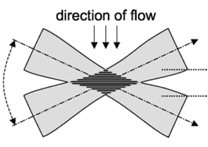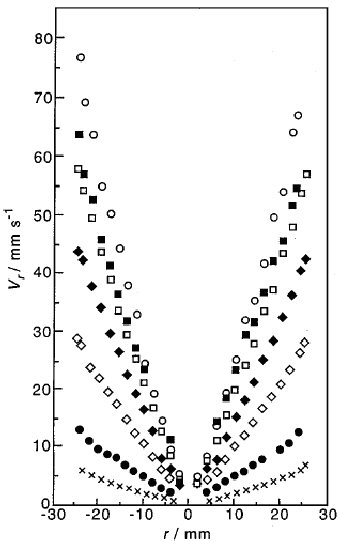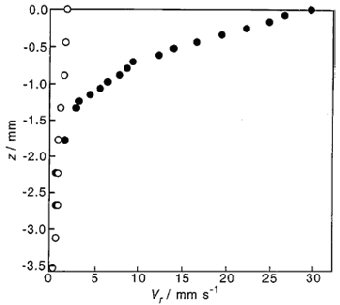Laser Doppler Velocimetry
Techniques: Laser Doppler Velocimetry
Introduction
The principle of laser Doppler velocimetry (LDV) is simple: a laser beam is split into two equal parts, which are then refocused at a point. In the intersection of the two beams, a standing wave pattern of interference fringes is set up (see below). Small particles or gas bubbles (either naturally present or deliberately added) passing through the focal volume scatter laser light. The scattered light is then detected, filtered to isolate the high frequency modulation caused by the interference fringes, digitised and Fourier transformed. The modulated frequency can then be related to the velocity of the bubbles or particles, and hence to the velocity of the fluid as well.

LDV gives us the ability to measure the hydrodynamics of moving fluid systems by making point-by-point measurements of the velocity within the flows. This data is often most useful when analysed in conjunction with adsorption data from techniques such as external reflection FTIR SPECTROSCOPY, ELLIPSOMETRY or NEUTRON REFLECTION.
LDV & The Overflowing Cylinder
An overflowing cylinder (OFC) provides a convenient method for studying non-equilibrium liquid interfaces under steady-state conditions. By crossing the laser beams just beneath the surface my group have used LDV to measure the surface velocity in the cylinder. When surfactants are added to the OFC they adsorb to the water surface which reduces the surface tension. The expansion rate of the cylinder is such that we can study adsorption on the 0.1 � 1 s timescale. The adsorbed amount is greatest in the centre of the surface where the surface expands the slowest, and the liquid expands radially outwards as shown in the velocity profiles below. A surface tension gradient is created across the surface which must be balanced by a viscous stress in the bulk. The resulting surface acceleration is an example of the Marangoni effect.

By crossing the laser beams further beneath the surface we have also looked at how deep these effects penetrate � this is the thickness of the hydrodynamic boundary layer. We found that the hydrodynamics are affected up to 1 mm beneath the surface (see below). The flat surface of an OFC is ideal for the application of spectroscopy, reflectometry and scattering techniques. Using all of this data together allows us to develop detailed models of surfactant adsorption in this system.

LDV & The Liquid Jet
Because a small liquid jet (approximately 1 mm diameter) expands faster than an OFC it can be used to study adsorption on the millisecond timescale. LDV has the spatial resolution that allows us to focus the laser beams very tightly, and that in this particular application the focal volume can be < 10 μm which allows very detailed mapping of the hydrodynamics. As surfactant solutions exit the nozzle the surface is almost pure water. Further down the jet surfactant adsorption reduces the surface tension. In this case the Marangoni effect acts to decelerate the jet surface (see below). Ellipsometry has also been applied to the liquid jet to study the surface coverage. In part of this work we have shown that micelles can adsorb directly to the expanding liquid surface.

